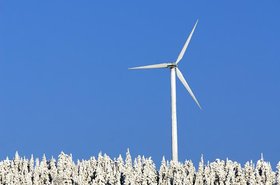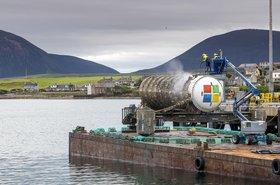Transitioning to renewable energy use is an important, but not easily achieved, goal. Although the past decade has seen significant improvements in IT energy efficiency, there are indications that this may not continue. Moore’s Law may be slowing, more people are coming online, and internet traffic is growing faster than ever before. As energy consumption increases, data center operators will need to transition to 100 percent renewable energy use 100 percent of the time.
Uptime Institute has recently published the report Renewable energy for data centers: Renewable energy certificates, power purchase agreements and beyond, covering the key components of renewable energy sustainability strategies for data centers. The tech industry has made considerable effort to improve energy efficiency and is the largest purchaser of renewable energy. Even so, most data center sustainability strategies still focus on renewable energy certificates (RECs). RECs are now considered to be low quality products because they cannot credibly be used to back claims of 100 percent renewable energy use.
To avoid accusations of greenwashing, data center operators must consider investing in a portfolio of renewable energy products. RECs may play a part, but power purchase agreements (PPAs) are becoming more popular, even though there can be financial risks involved.
A stepwise approach will ease the process. There are four steps that data center operators need to take on the journey toward the use of sustainable, renewable energy.
1. Measure, report, offset
Electricity is just one component of the carbon footprint of an organization, but it is relatively easy to measure because exact consumption is regularly reported for billing purposes. Tracking how much electricity comes from renewable and nonrenewable sources allows decisions to be made about offsets and renewables matching. This breakdown can be obtained from the electricity supplier, or grid-level emissions factors can be used. For example, in the US this is published annually by state by the Energy Information Administration; other countries provide similar resources. (A more formal methodology is explained in the Greenhouse Gas Protocol Scope 2 guidance.)
Once total emissions are known (that is, total emissions from electricity ― the full organizational emissions also need to be calculated), the next step is to buy offset products to mitigate the existing impact. However, there are significant challenges with ensuring offset quality, and so offsetting is only a stopgap measure. Ideally, offsets must be reserved for emissions that cannot be reduced by other measures (e.g., by switching to 100 percent renewable energy).
Measurement and reporting are crucial to understanding carbon footprint and are effectively becoming a necessary function of doing business. The reporting of carbon emissions is becoming a legal requirement for larger companies in some jurisdictions (e.g., the UK). Some companies are starting to require carbon reporting for their suppliers (for example, Apple and Microsoft, because of their own goals to be carbon-neutral/negative by 2030).
Data center operators who are not already tracking carbon emissions associated with electricity purchases may have to invest significant resources to catch up should reporting become required.
2. 100 percent renewables matching
Ideally, all electricity used should be 100 percent matched by renewable energy production. So far in the data center industry, 100 percent renewables matching has generally been achieved through purchasing RECs, but PPAs (direct, financial, or through green supply arrangements) must now take over as the dominant approach. RECs can act as a stopgap between taking no action and using tools such as PPAs, but they should eventually be a small component in the overall data center sustainability strategy.
3. Power purchase agreements
Purchasing RECs is a reasonable first step in a sustainability strategy but is insufficient on its own. Establishing direct/physical PPAs with a nearby renewable energy generator, combined with their associated RECs, is the gold standard necessary to truly claim 100 percent renewable energy use. However, even this does not mean 100 percent renewable energy is actually being used by the data center, just that an amount of purchased renewable energy equivalent to the data center’s energy use was added to the grid. Virtual/financial PPAs are an option where the power market does not allow direct retail PPAs.
Both types of PPA involve pricing risk or can act as a hedge against wholesale price changes. For direct PPAs, the fixed price provides certainty — but if wholesale prices fall, buyers may be stuck in a long-term contract paying more than the current market price. Virtual/financial PPAs introduce further complexity and financial risk: if the wholesale price falls below the agreed-upon strike price at the time of purchase, the buyer must pay the supplier the difference, which may be significant.
Despite these risks, the use of PPAs is growing rapidly in the US, particularly in the tech and communications sectors. Operators with advanced sustainability programs have been buying PPAs for several years, either directly through financial/virtual PPAs, or by using green supply agreements through a utility. Our report covers these options in more detail.
4. 24x7 renewable energy use
Most matching (of renewable energy purchased against energy actually used) happens on an annual basis but shifts in generation (the grid mix) happen at a much lower granularity. There are strategies to smooth this out: different sources of renewable energy can be combined to create blended PPAs, such as combining wind and solar energy production with storage capacity. This is useful because different sources generate at different times (for example, wind can generate energy at night when solar energy is unavailable).
In 2019, Microsoft and Vattenfall announced a new product to provide hourly renewables matching. The pilot started at Microsoft’s Sweden headquarters and will provide hourly matching to a new Azure cloud region in 2021. No data center operator has achieved 24x7 matching for its entire global fleet, although some are almost there for individual sites (e.g., in 2019, Google achieved 96 percent renewable energy use in Oklahoma [US], and 61 percent on an hourly basis globally).
This is the objective: 24x7 renewable energy use, 100 percent of the time. Matching on an annual basis is not enough to reach the goal of decarbonizing the electricity grid. All demand ― 100 percent ― must be supplied by 100 percent renewable energy, 100 percent of the time. This will, of course, take many decades to achieve in most economies.





